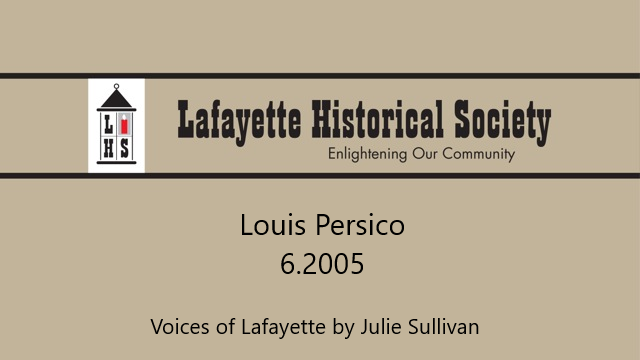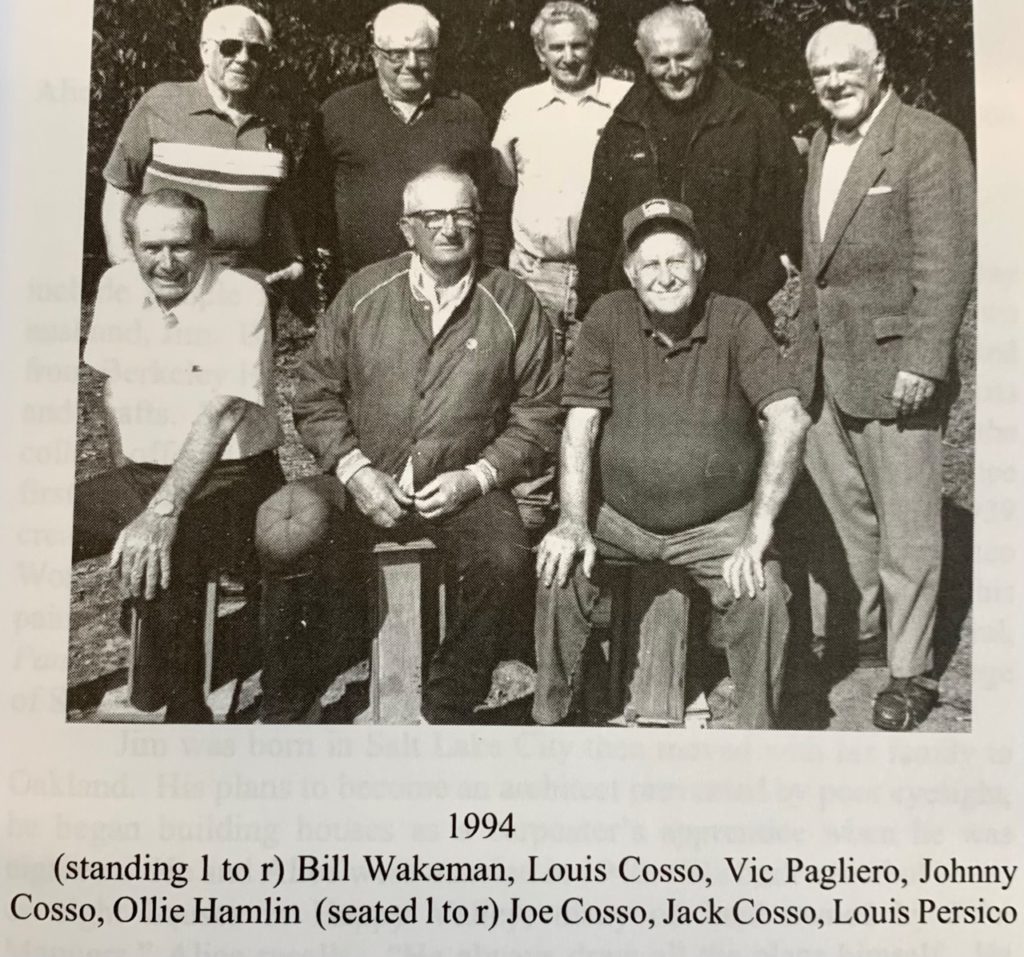Summary:
Louis Persico was interviewed in June 2005. He was born in Oakland in 1918, but a year later his family moved to Lafayette, where they at first operated a farm on the present day site of Acalanes High School. After serving as a mess sergeant in World War II, including the Battle of the Bulge and the Battle at Remagen, Louis returned to Lafayette and worked in the baking business and then at Russell Bruzzone’s liquor store. He shares memories of the Lafayette businesses he remembers from his 50 years working in the community.
Oral History:
There isn’t much about pre-World War II Lafayette that Louis Persico doesn’t remember, which may be why his friends call him a ‘walking historian.’ “I was born in Oakland in 1918,” he says. “My parents, Antonio and Anna Persico, brought me to Lafayette in 1919. My dad originated Oakland Building Maintenance, a janitorial service, with one partner. His friends, the Martinos, bought an old car and brought us out here for an outing, and my mom announced Lafayette was where she wanted to live. When the Martinos moved to Lafayette, we moved right along with them.”
Both Louis’ parents were born in Italy. His father settled in Boston, then came to Oakland around 1916, where he met Louis’ mother. Louis grew up speaking both Italian and English.
“When we moved here everything was horse and buggy,” he remembers. “Farmers used to deliver produce in horse-drawn wagons. They would line up and go all the way into Oakland up over old Tunnel Road through the old tunnel. It used to rain inside that tunnel all the time.”
Louis’ father and his uncle, also named Louis, farmed for a year on land where Acalanes High School is today. Then the family moved to Happy Valley near Colonel Garrett’s ranch, where they farmed until 1925. “Then we moved to where Safeway is now,” Louis explains. “They used to call that Knudsen’s Ranch. We rented about sixty acres. When I graduated from high school in 1937 my uncle got sick, so I helped my dad farm for a year. Things weren’t that good in farming, so we got out of it. My dad bought an acre in lower Happy Valley on what was known as Woody’s Place. Every place had a name in those days. He got a job with the Hotel Claremont, and my uncle went to work for Black and White Liquors in Oakland.
“My dad bought a Model T truck, but he said the horses were faster. That thing only went about ten miles an hour,” Louis remembers with a chuckle.
“I wanted to go into business for myself, and my dad knew one of the partners in the Liberty Baking Company in Oakland. Dad loaned me the money, and in 1940 I became one of six partners in the company. It was located at 43rd and Telegraph. Liberty made French bread. I was in sales, but I could bake if I had to. I knew all the fundamentals.”
Louis served as a mess sergeant in the Army Ninth Armored Division in Europe in World War II. “We fought in the Battle of the Bulge and the crossing of the Remagen Bridge,” he says. “I remember feeding General Patton’s men for six straight hours. That got me one of the first furloughs in our company. I was discharged as a Staff Sergeant almost exactly four years later in October 1945.” When he came home, he returned to his partnership in the bakery, becoming sales manager and covering all of Alameda and Contra Costa Counties, then later president. “I was there for twenty-three years until we sold out to Columbo Baking in 1963. I stayed with Columbo for seventeen years and finally retired in 1980.”
After that Louis accepted a part-time office job with Russ Bruzzone in his liquor store. “I went there for a couple of years and wound up working twenty-three years,” he adds with a chuckle.
Louis attended Lafayette Grammar School, “the new school on School Street and Moraga Way” and graduated from the Lafayette Town Hall. He rode the train to Mt. Diablo High School in Concord. “Mt. Diablo High covered a huge area,” he remembers. “All the way from the Canyon to Rudgear Road to Clayton to Bella Vista, which is now Bay Point, to Nichols and Port Chicago. The kids from Orinda went to Richmond High.” He ran track at Mt. Diablo when the team set a record in the Martinez Relays that stood for seventeen years.
“When we came here, Lafayette was a farming community,” Louis remembers. “It was a combination of nationalities: Italian, Portuguese, a few Japanese, Irish, German and English. The Italians grew the vegetables, the Japanese grew the fruit, the Portuguese grew hay and raised cattle. The Irish, Germans and English had the garages and grocery stores. We’d help each other, and we were all great friends. It was just like a big, happy family. When you’d go to town and come home, you’d have wasted a couple of hours just talking to everybody.”
Louis, who never married, lived with his parents in their home on Thompson Road. They passed away in 1977. He continues to live in the family home.
Louis can visualize Lafayette as it was in the early 1930’s and ’40’s. “I’ll start with where the theater is now. There was a little meat market there run by Mr. Medau. Where Handlebar Toys (formerly Handlebar Bicycles) is now was originally McNeil’s grocery. Across the street where Starbuck’s is used to be Stark’s grocery. On the corner was Rupp’s meat market, and where the Roundup is Mrs. Hunt had an ice cream shop. Later Lou Borghesani started the Roundup bar and restaurant. In between was a Richfield Gas station.
“A little further up near Postino was a little grocery store run by Mr. Truax. The corner with the Shell station (now Lafayette Mercantile) used to be the Lafayette Garage, which was owned by Harry Boyer, who also had the fire department. When they tore the garage down, the fire department moved in back of where World Savings (Wachovia) is today. The garage there was owned by Vaughn Wing and Louis Oliveira. They sold out to El Molino, then later it was torn down, and Lafayette Food Center went in there in the 1940’s.
“When you come up a little further on Mt. Diablo, the Schwartz family opened a restaurant called the Tunnel Inn, later bought out by Jay Bedsworth, and later Mr. Petar changed it to Petar’s. That was after the war. The Seafood Grotto was right alongside it. Where Cape Cod House used to be (now Celia’s) was known as The Curve. Harry Sollers ran it. He lived on Miller Avenue, which was named after Grant Miller, a prominent Oakland mortician. Mr. Miller owned a place here and used to come horseback riding. On his way here, his car ran over a bank and he was killed.”
Lafayette was very rural when Louis grew up here. “We used to hunt all over with the Cosso family, duck and pheasant. We always hunted together. I grew up with that family and the Rossi family. John Cosso’s brother, Jack, was one of my partners in the bakery.
“The big change in Lafayette came when they opened the Caldecott Tunnel in 37. People started coming out here and buying little pieces of land. Before the war, Oakland was the best place to live, and when we wanted to go out, that’s where we went. I used to love to go to Berkeley, to Hink’s department store, too. I think all the ladies in Lafayette went to Hink’s.
“Mr. Garibotti came to town and built the Garibotti Building and La Fiesta Square. He owned Black and White Liquors on Telegraph in Oakland, but he lived on the hill behind where Pasta Per Tutti is today. I remember him telling my dad to buy property. The block above had Stark’s grocery that eventually became Meyers Groceteria. Sparling had the corner drug store. Down the way where Johnny’s Donuts is today, they built the Penny Saver Market.
“Where Safeway is, the postmaster, Mrs. Van Meter, lived. Later Mrs. Amelia Schutt ran the post office across the street. Her brother was a highway patrolman. He covered from the tunnel all the way down Rudgear Road in Walnut Creek and all the way to Moraga. In the late 30’s they finally brought in another patrolman to help him.
“I used to like the dances they held in the old Town Hall,” he says with a smile. Starting in 36 they used to have what they called Forty- niner Days from Friday to Sunday to raise money for the fire department. They’d have a parade through town, then a dance upstairs and slot machines downstairs. Ed Morrison was chief of the volunteer fire department, but after the war we got a full-time department. The police department came later.”
Louis says Lafayette really started to change in the 1960’s. “A lot of the old-timers moved out,” he says with a shake of the head. “All the Portuguese families left town. Naturally you like the old times. It’s congested here now, but what are you going to do? One of the best changes that came to town was when they built BART. A lot of people didn’t want it, but what would we do without it now?
“Lafayette’s going to be like Hillsborough and the Peninsula,” he adds. “A real estate person told me only about fifteen per cent of today’s buyers can qualify for a home in Lafayette. Poor people can’t come in here any more.”
This interview is excerpted from Voices of Lafayette, by Julie Sullivan. This book is available for purchase in the History Room.



Leave a Reply